Dolby Asteria
October 2018 ––For Dolby's ongoing site-specific installations at its unique gallery space in San Francisco, Munky and Tool of North America created an augmented reality audiovisual quest across the stars. Asteria, inspired by Nasa's Jet Propulsion Laboratory and cosmic mythology, consists of a 3-act, mobile AR experience for iOS devices synchronized with a 12 minute film that plays on loop on the gallery’s 64-foot LED wrap around wall.
Inspired by the Dolby Gallery itself, Munky and Tool of North America worked to design an AR experience that pairs with the big screen, coupling the two platforms to create this immersive space exploration. Putting the user in the stereoscopic transmissions of the “xO-9 probe” explorer, they’re taken to three different worlds in the year 2027, each world in a different state of worldly evolution; each corresponding to a unique epoch in Earth’s own development.
Inspired by the Dolby Gallery itself, Munky and Tool of North America worked to design an AR experience that pairs with the big screen, coupling the two platforms to create this immersive space exploration. Putting the user in the stereoscopic transmissions of the “xO-9 probe” explorer, they’re taken to three different worlds in the year 2027, each world in a different state of worldly evolution; each corresponding to a unique epoch in Earth’s own development.
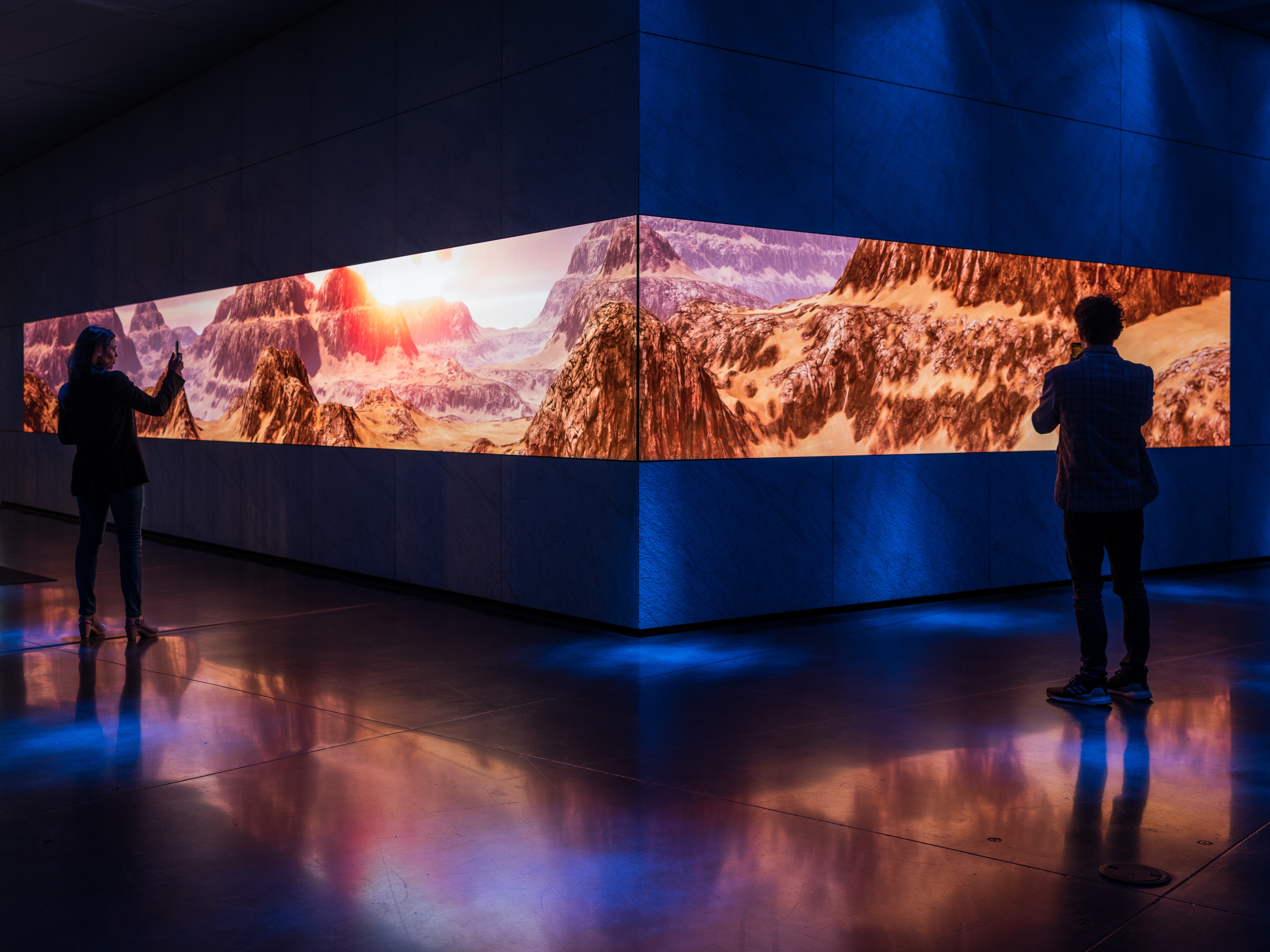

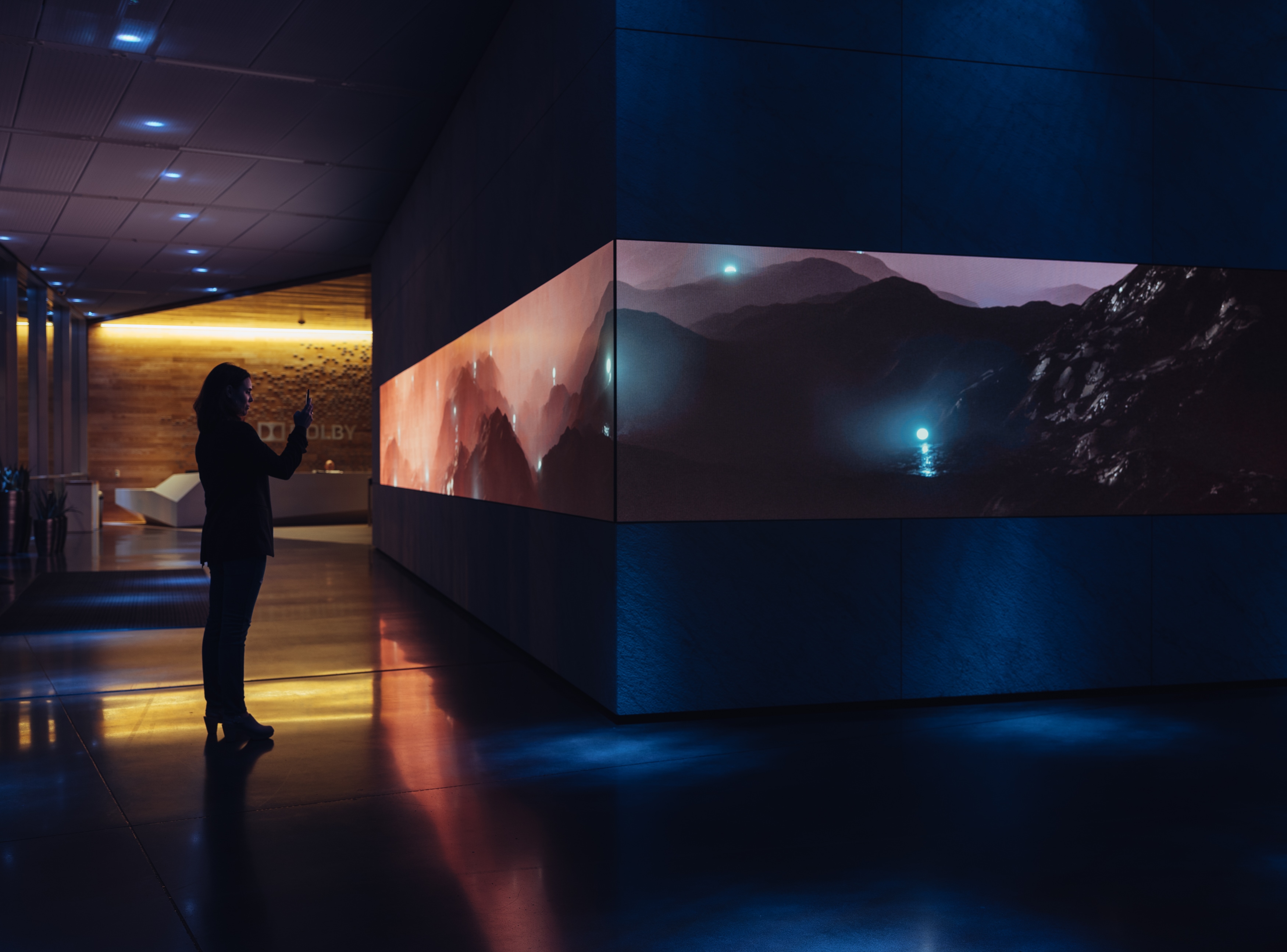
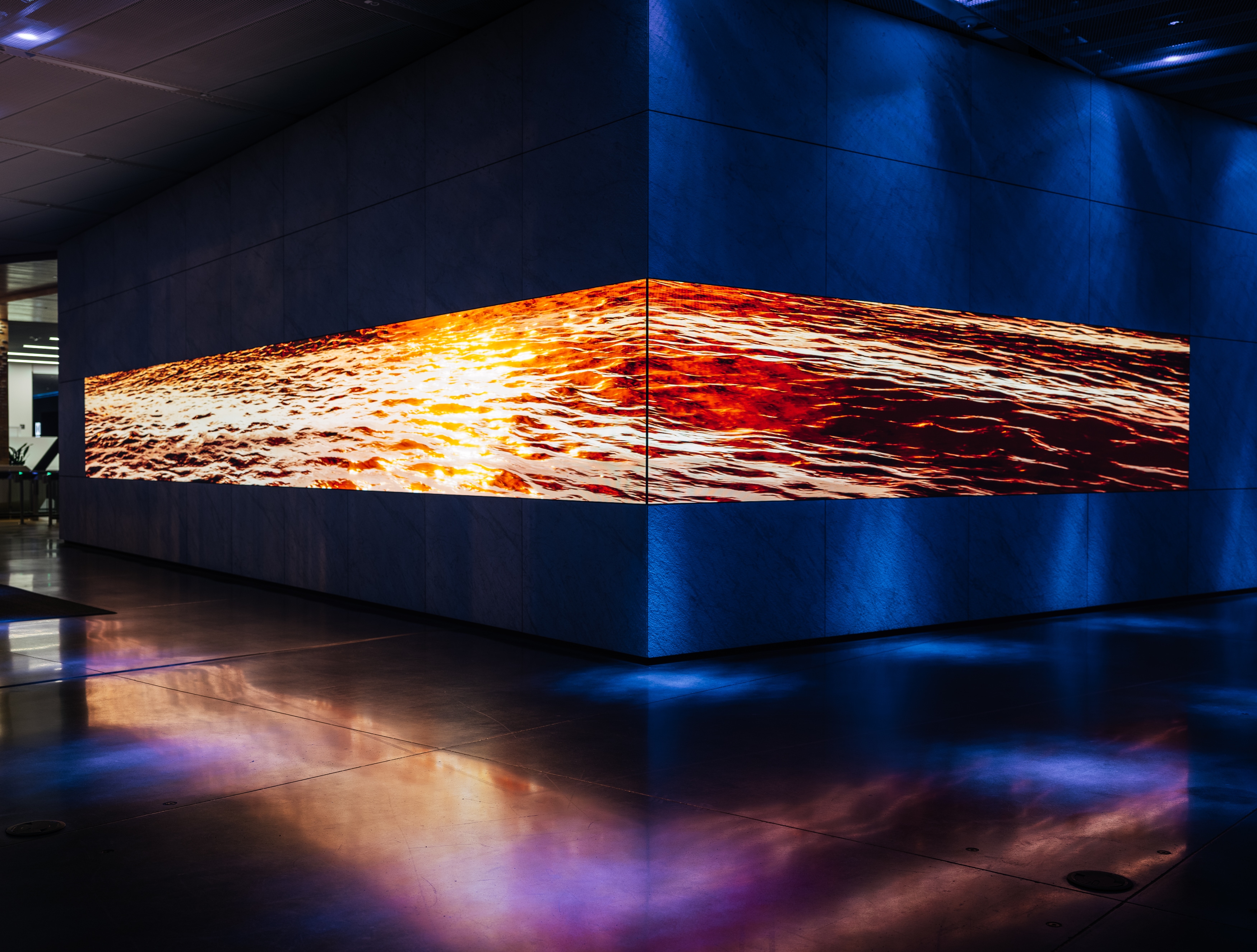

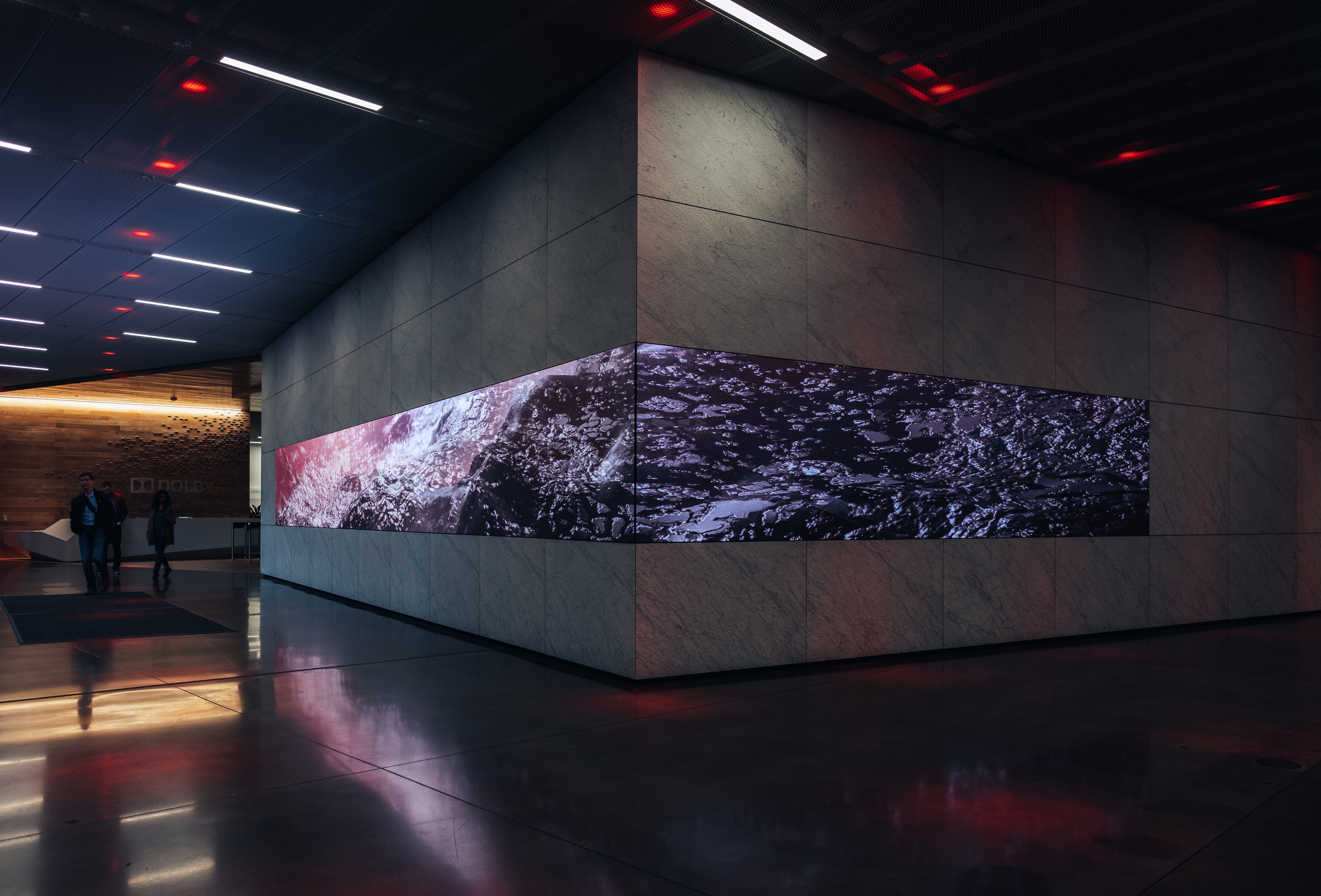








The Process
–– 02Leveraging real-time programming, audio-reactive 3D visuals, and immersive Dolby Atmos mixing, celestial bodies move through space while exoplanetary terrain is projected onto the gallery’s LED Ribbon Wall. With Dolby Atmos, sound is not constrained to channels, but moves around you in the three-dimensional space. The Dolby sound system allows users to pan around with their smartphones and be surrounded by sound throughout the gallery, creating a multi-immersive futuristic space adventure, supported by visuals inspired by scientific research and data. Munky and Unity Artist, Jeff Bryant, worked together to design the story and visuals behind the three planets in the installation, envisioning the project by looking towards the future of space travel.
–– 02
The Augmented Reality
–– 03After giving thought to the space, Munky decided to pair the screen with an AR experience, using the screen as a backdrop and the source of life and sound for the installation. The smartphone thus becomes an extension of the story that is being told by the film.
In order to create the best experience for the user and to create a smooth transition between worlds and storylines, Munky designed the AR app to pair with the Dolby screen content. By using a remote server to track time-code sync, the AR app on the user’s mobile device is able to detect where the user is within the gallery film, allowing it to stay synced with their location within the film so each act is experienced in a perfect sequence.
In order to create the best experience for the user and to create a smooth transition between worlds and storylines, Munky designed the AR app to pair with the Dolby screen content. By using a remote server to track time-code sync, the AR app on the user’s mobile device is able to detect where the user is within the gallery film, allowing it to stay synced with their location within the film so each act is experienced in a perfect sequence.
–– 03

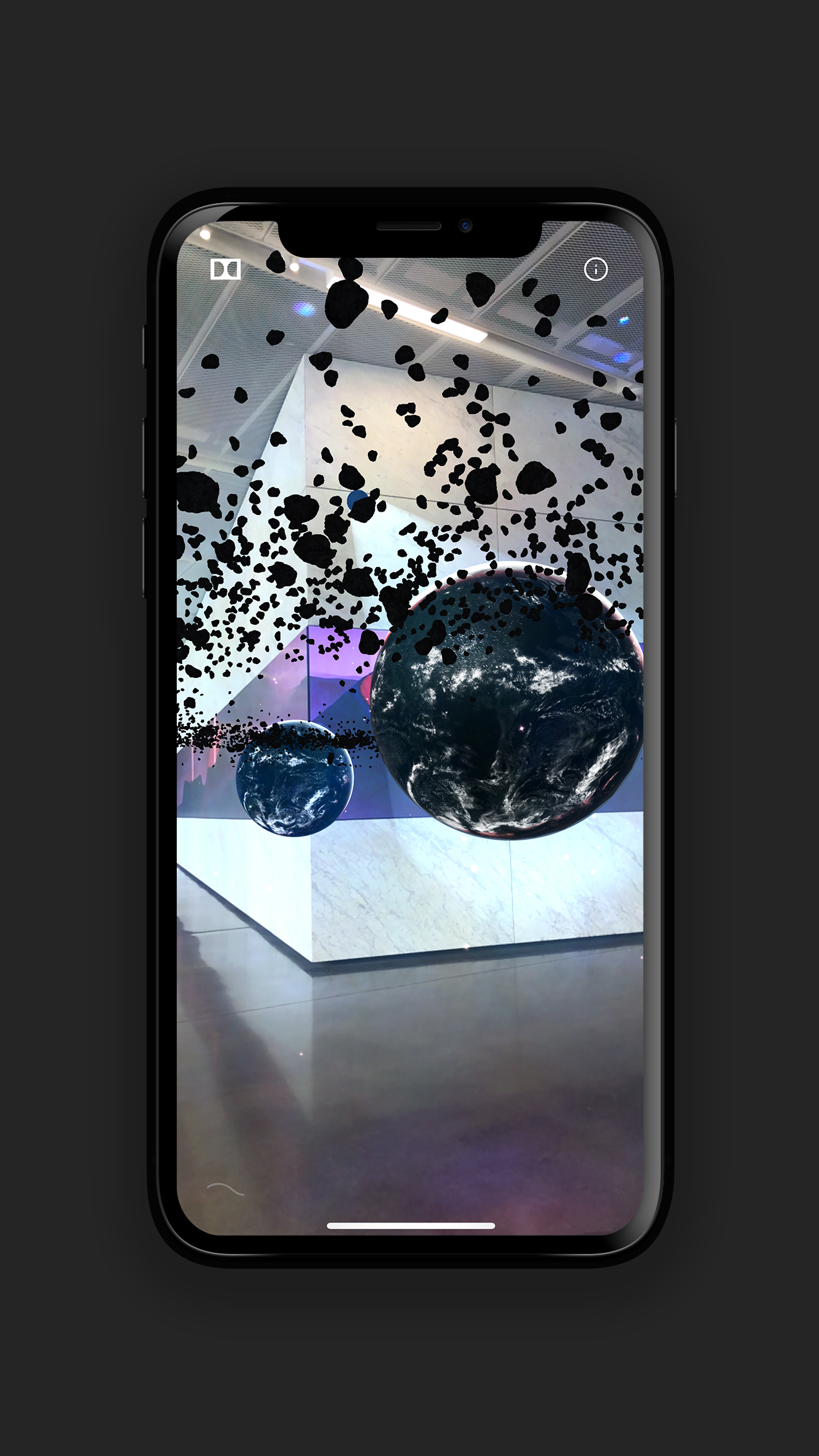


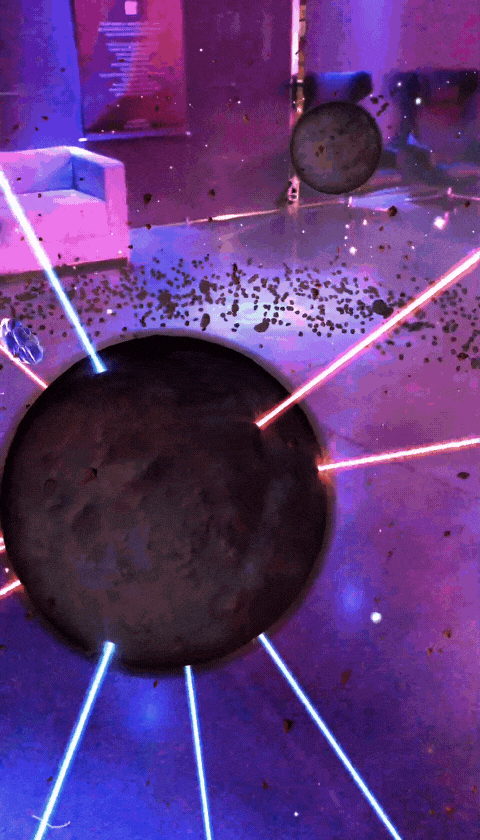


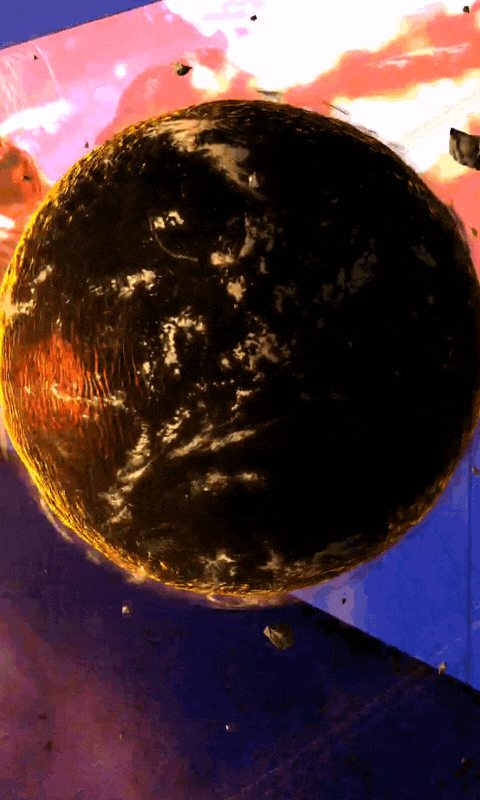

The Narrative
–– 04In 2027, the xO-9 probe became the first lunar launch module to maintain contact with NASA after successfully jumping an interstellar gate.
Radio contact after the black hole transit located the ship 2 million light years from Earth, near a cluster of exoplanets called Macaca Fascicularis, on the edge of galaxy Andromeda.
Equipped with the most advanced HDR imaging and sound-capturing technologies, xO9’s mission is to navigate, observe, and transmit stereoscopic images from deep space. The Macaca cluster is of particular interest because each planet has it own orbital sun - and in one case, suns.
More astonishing is the discovery that each planet exists in a different state of worldly evolution; each corresponding to a unique epoch in Earth’s own development. And one that may even foreshadow our own uncertain future.
These holographic broadcasts represent the first time humans can experience space as if they are window-seat passengers in an explorer probe. The xO-9 transmissions - miniaturized for viewing as observable micro-universes - create a dimensional experience for the viewer. Like galactic mobiles that float in space wherever the viewer chooses to call them up.
Radio contact after the black hole transit located the ship 2 million light years from Earth, near a cluster of exoplanets called Macaca Fascicularis, on the edge of galaxy Andromeda.
Equipped with the most advanced HDR imaging and sound-capturing technologies, xO9’s mission is to navigate, observe, and transmit stereoscopic images from deep space. The Macaca cluster is of particular interest because each planet has it own orbital sun - and in one case, suns.
More astonishing is the discovery that each planet exists in a different state of worldly evolution; each corresponding to a unique epoch in Earth’s own development. And one that may even foreshadow our own uncertain future.
These holographic broadcasts represent the first time humans can experience space as if they are window-seat passengers in an explorer probe. The xO-9 transmissions - miniaturized for viewing as observable micro-universes - create a dimensional experience for the viewer. Like galactic mobiles that float in space wherever the viewer chooses to call them up.
–– 04
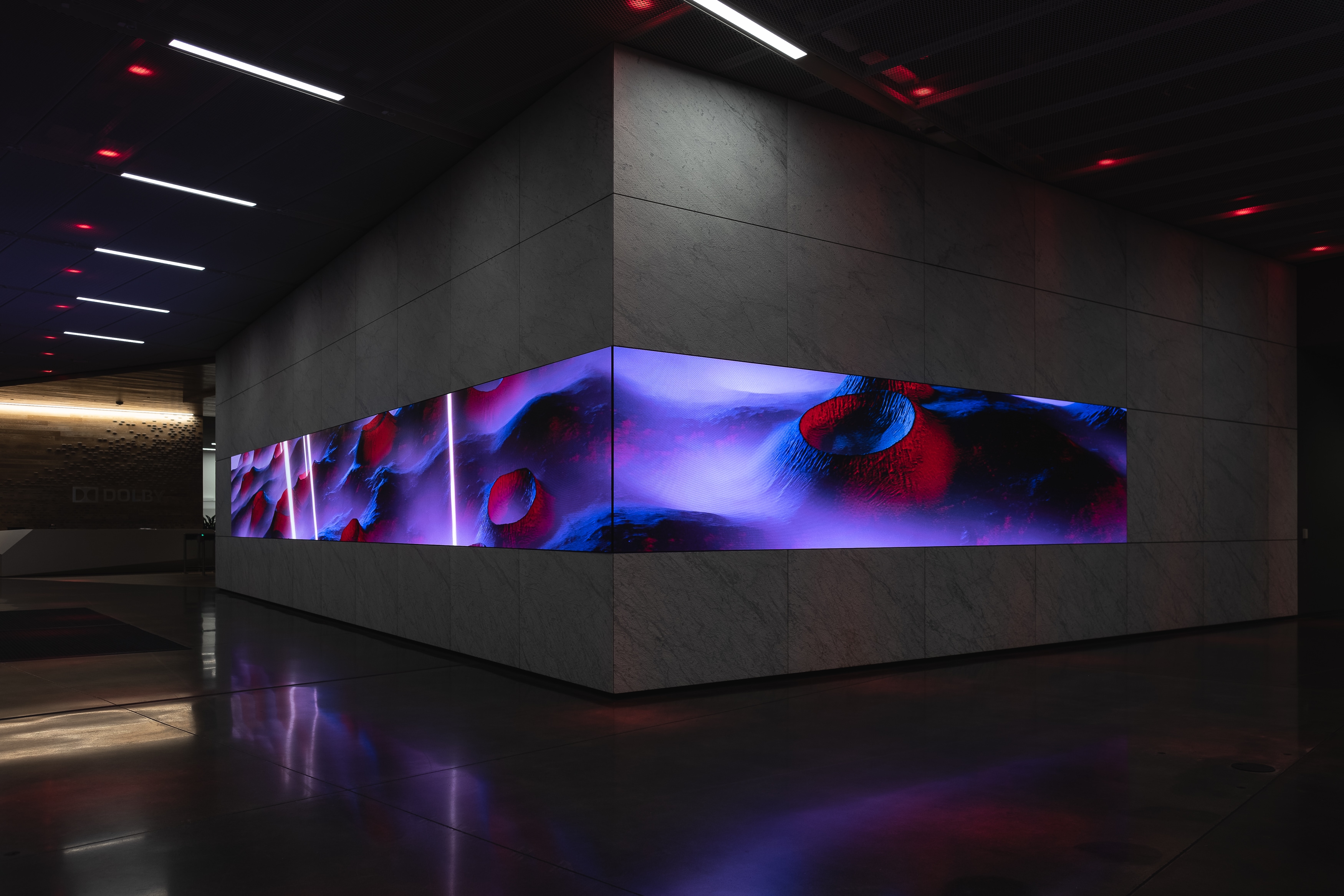
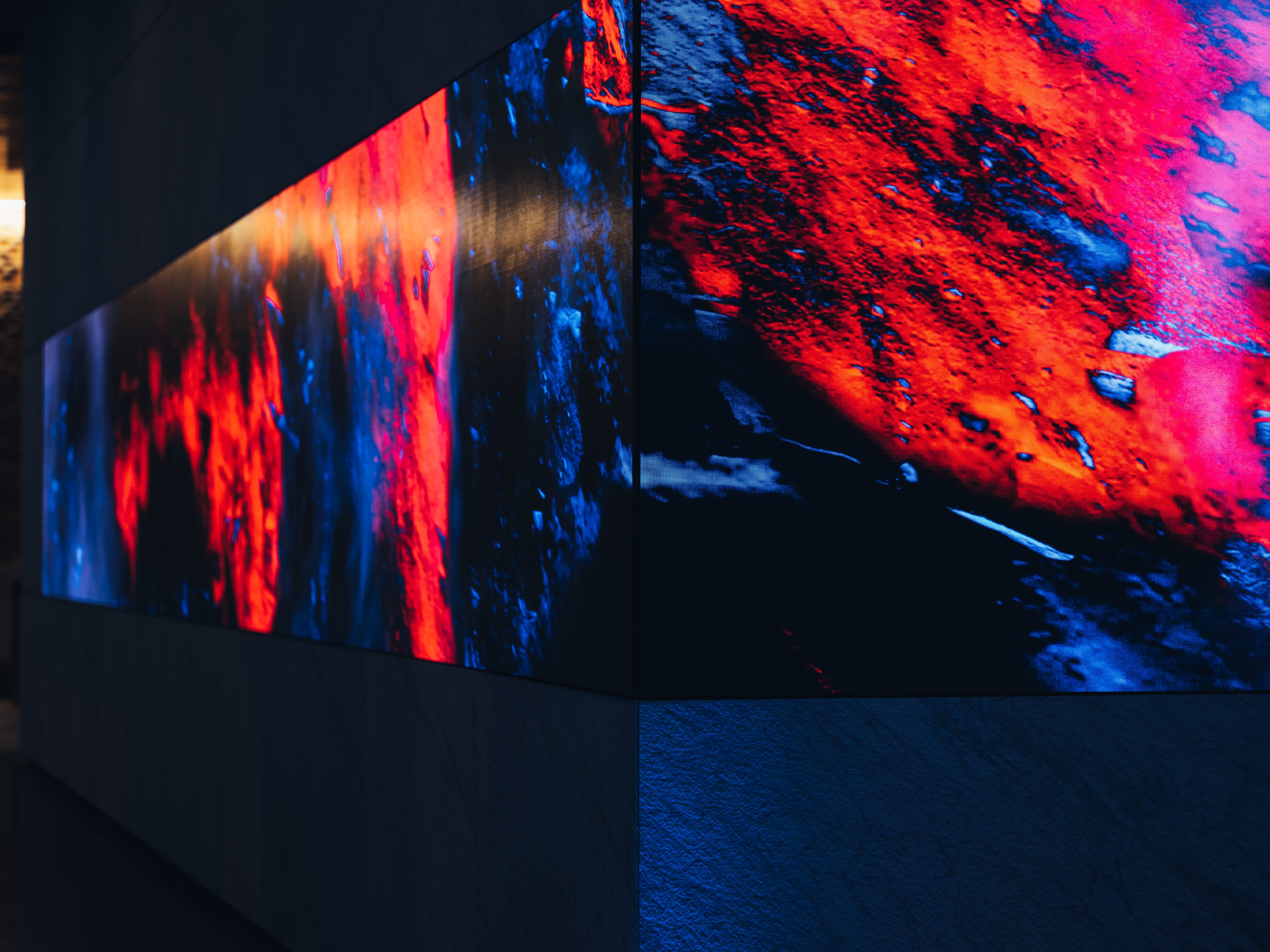


Chrysalis
–– 05On the extreme perimeter of the galaxy Andromeda is the planet Chrysalis, the youngest of the three worlds.
Named for its emergent terrestrial properties, Chrysalis is emerging from a series of major tectonic events during which its landscape was molded. Perhaps the most striking feature of Chrysalis is how much its surface resembles that of prehistoric Earth. So much so that astrogeologists refer to the planet as a Pliocene, the epoch that Earth emerged from 2 million years ago.
The approach to Chrysalis is harrowing.
The planet is surrounded by a thick asteroid belt that circles slowly in orbit. On the perimeter is a massive ring-shaped object called the Sentinel.
Approaching in a night pass from beyond the terminator line, xO-9’s descent pulls back the dark curtain of night. This daybreak fly-over illuminates a desert rippled with dunes. And dotted with unidentifiable orbs of light that give the sense of nascent life.
Cosmic rain pummels a dark mountainous terrain, spurring mudslides and electrical storms that look as if the xO-9 has journeyed to the heart of a Tesla coil.
Chrysalis is orbited by not one but two dwarf stars that transit like spotlights across a prison planet. A spectral borealis throws a translucent layer on the sky that feels like skin vanishing from the cocoon of an embryonic world.
One light year beyond Chrysalis lies the planetary cluster called Luca Prima.
Named for its emergent terrestrial properties, Chrysalis is emerging from a series of major tectonic events during which its landscape was molded. Perhaps the most striking feature of Chrysalis is how much its surface resembles that of prehistoric Earth. So much so that astrogeologists refer to the planet as a Pliocene, the epoch that Earth emerged from 2 million years ago.
The approach to Chrysalis is harrowing.
The planet is surrounded by a thick asteroid belt that circles slowly in orbit. On the perimeter is a massive ring-shaped object called the Sentinel.
Approaching in a night pass from beyond the terminator line, xO-9’s descent pulls back the dark curtain of night. This daybreak fly-over illuminates a desert rippled with dunes. And dotted with unidentifiable orbs of light that give the sense of nascent life.
Cosmic rain pummels a dark mountainous terrain, spurring mudslides and electrical storms that look as if the xO-9 has journeyed to the heart of a Tesla coil.
Chrysalis is orbited by not one but two dwarf stars that transit like spotlights across a prison planet. A spectral borealis throws a translucent layer on the sky that feels like skin vanishing from the cocoon of an embryonic world.
One light year beyond Chrysalis lies the planetary cluster called Luca Prima.
–– 05





















Luca Prima (I, II, III)
–– 06Though a further distance from Earth than Chrysalis, the three planets of Luca Prima were detected first. A discovery made by astronomers at NASA’s Jet Propulsion Laboratory through an observational technique called microlensing, which is caused by the deflection of light by a massive object.
And massive they are.
The xO-9 probe spend five years exploring these Neptune-sized exoplanets that are approximately 10 times the mass of Earth. And the closest in evolution to Earth than any planetoid ever to be detected by our telescopes.
Perhaps it is fitting for worlds of such cosmic immensity to have three of their own suns orbiting in a geocentric formulation. This a reminder of the pre-Copernican model, which placed the Earth in the center of our universe.
Though the three planets are nearly identical in size and terrestrial features, the presence of Uranus-like rings around Luca Prima I (LP I) create a breathtaking spectacle as the xO-9 breaches the perimeter of the cluster.
The first images broadcast from the probe’s descent to LP I are of a watery world bathed in the light of what appears to be perpetual daybreak. Algae blooms shimmer on the surface of LPI’s massive Archyon sea, while the xO-9’s multi-beam sonar equipment reveals the existence of vast underwater coral reefs. And inland, freshwater rivers flow from a system of mountain ranges that traverse each of the planet’s eleven continents.
All determiners of potential, viable habitats for extraterrestrial life.
But the gravitational anomalies of Luca Prima caution that this is a strange and alien world. Astrophysicists have been mystified by the massive, multi-ton boulders that float, like weightless armadas, just above the terrain.
And massive they are.
The xO-9 probe spend five years exploring these Neptune-sized exoplanets that are approximately 10 times the mass of Earth. And the closest in evolution to Earth than any planetoid ever to be detected by our telescopes.
Perhaps it is fitting for worlds of such cosmic immensity to have three of their own suns orbiting in a geocentric formulation. This a reminder of the pre-Copernican model, which placed the Earth in the center of our universe.
Though the three planets are nearly identical in size and terrestrial features, the presence of Uranus-like rings around Luca Prima I (LP I) create a breathtaking spectacle as the xO-9 breaches the perimeter of the cluster.
The first images broadcast from the probe’s descent to LP I are of a watery world bathed in the light of what appears to be perpetual daybreak. Algae blooms shimmer on the surface of LPI’s massive Archyon sea, while the xO-9’s multi-beam sonar equipment reveals the existence of vast underwater coral reefs. And inland, freshwater rivers flow from a system of mountain ranges that traverse each of the planet’s eleven continents.
All determiners of potential, viable habitats for extraterrestrial life.
But the gravitational anomalies of Luca Prima caution that this is a strange and alien world. Astrophysicists have been mystified by the massive, multi-ton boulders that float, like weightless armadas, just above the terrain.
–– 06



































Elektra
–– 07On the edge of the galaxy Andromeda, and hidden within the constellation Cassiopeia, lies NGC 185, a dwarf galaxy that is home to the planet Elektra.
Tiny in comparison to the Earth. Elektra has a radius 2,460 miles and is roughly the same size as Mars. Ingress was difficult as the planet is orbited by plasma-filled asteroids, up to ten times its size. This was complicated by the high velocity of solar wind in the planet’s magnetosphere - the region of space dominated by the exoplanet’s magnetic field.
Upon its breach of Elektra’s ionosphere, the xO-9 began to pick up high levels of radiation that initially blanked the probe’s monitoring instruments. Once contact was restored, NASA began to detect massive emissions from the surface. Initial visual collects indicated these were laser beams unlike anything recorded in space.
Surveys of the landscape indicated large dome-like structures and radio frequencies originating from a system of complex astral trenches.
The probe maintained its trajectory and, once operational within the atmosphere, began to return images of what NASA now can confirm is an advanced civilization of extraterrestrial life. As it approached one of the domes, the xO-9 received a transmission that SETI analysts could not decipher.
Moments after its receipt of the alien message, JPL lost contact with the xO-9 probe and assumed the worst of fates in this mysterious plane.
Tiny in comparison to the Earth. Elektra has a radius 2,460 miles and is roughly the same size as Mars. Ingress was difficult as the planet is orbited by plasma-filled asteroids, up to ten times its size. This was complicated by the high velocity of solar wind in the planet’s magnetosphere - the region of space dominated by the exoplanet’s magnetic field.
Upon its breach of Elektra’s ionosphere, the xO-9 began to pick up high levels of radiation that initially blanked the probe’s monitoring instruments. Once contact was restored, NASA began to detect massive emissions from the surface. Initial visual collects indicated these were laser beams unlike anything recorded in space.
Surveys of the landscape indicated large dome-like structures and radio frequencies originating from a system of complex astral trenches.
The probe maintained its trajectory and, once operational within the atmosphere, began to return images of what NASA now can confirm is an advanced civilization of extraterrestrial life. As it approached one of the domes, the xO-9 received a transmission that SETI analysts could not decipher.
Moments after its receipt of the alien message, JPL lost contact with the xO-9 probe and assumed the worst of fates in this mysterious plane.
–– 07






















Dolby Asteria Credit List
Director: GMUNK
Lead Unity Artist: Jeff Bryant
Composer: Keith Ruggiero
Concept Writer: Stephen Marshall
Production Company: Tool
Managing Partner: Dustin Callif
Executive Producer: Julia Sourikoff
Head Of Production: Chris Kaliszewski
Client: Dolby
Creative Director: Robin Juan
Executive Producer: Amanda Schneider
Technical Director: John Loose
Technical Adviser: Bennett Schatz
Sound Mix: Erik Foreman
NASA Consultant: Sasha Samochina
Unity Consultant: Timoni West
Director: GMUNK
Lead Unity Artist: Jeff Bryant
Composer: Keith Ruggiero
Concept Writer: Stephen Marshall
Production Company: Tool
Managing Partner: Dustin Callif
Executive Producer: Julia Sourikoff
Head Of Production: Chris Kaliszewski
Client: Dolby
Creative Director: Robin Juan
Executive Producer: Amanda Schneider
Technical Director: John Loose
Technical Adviser: Bennett Schatz
Sound Mix: Erik Foreman
NASA Consultant: Sasha Samochina
Unity Consultant: Timoni West
Press Links
Dexigner –– NASA-Inspired AR Installation at Dolby Gallery
AV Magazine –– Dolby Gallery AR show offers window seat on space probe
FWA –– Dolby Asteria FWA of the Day
Awards List
District 15 American Advertising Awards
Innovative Use of Interactive/Technology – Gold
Augmented Reality – Gold
Responsive Design – Gold
Los Angeles American Advertising Awards
Innovative Use of Interactive/Technology – Silver
Out-Of-Home Installation – Silver
Augmented Reality – Silver
Dexigner –– NASA-Inspired AR Installation at Dolby Gallery
AV Magazine –– Dolby Gallery AR show offers window seat on space probe
FWA –– Dolby Asteria FWA of the Day
Awards List
District 15 American Advertising Awards
Innovative Use of Interactive/Technology – Gold
Augmented Reality – Gold
Responsive Design – Gold
Los Angeles American Advertising Awards
Innovative Use of Interactive/Technology – Silver
Out-Of-Home Installation – Silver
Augmented Reality – Silver